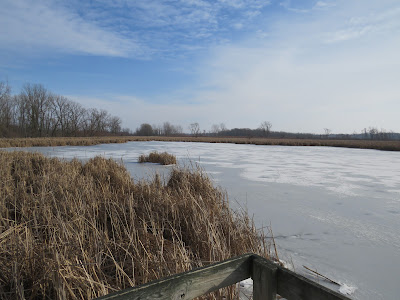With temperatures in the mid 30’s and a brisk wind at my back, I’m hiking east along a 12- ft. wide berm in a massive cattail marsh of the Maple River State Game Area, 30 miles south of Alma. Overhead, a leafless tree reveals a vacant Baltimore Oriole nest among branches sprouting catkins. These nests consist of tightly woven plant fibers, strips of bark, grapevines, grass, yarn, string, lined with fine grass, plant down and hair. The only reason there aren't more old nests hanging from trees is because often times the female will use material from her old nest to make a new one. Orioles don't reuse an old nest, but they certainly will recycle one. On another tree nearby, I observe a Bald-face hornets’ nest. In the fall, hornet males and new queens are produced. These leave the nest, mate, and the fertilized queens hibernate. The remainder of the workers, the old queen, and the males die of old age or freezing temperatures. Nearby, I come upon some squirrel tracks as well as rope-like, hairy, leafless vines of poison ivy clinging to a tree trunk. Further ahead, I pause as the westerly wind blows through a mix of Reed Canary grass and Teasel. Among the hundreds of acres of dead cattails, I notice several snow-capped mounds of plant material made by Muskrats. The larger ones, called lodges are built by first heaping plant material and mud to form a mound. A burrow is then dug into the mound from below the water level and a chamber is fashioned for them to shelter from freezing temperatures, avoid predation and sleep. The smaller ones, called push-ups are built away from the main lodge. When the ice is still very thin, muskrats push plant materials up through holes in the ice, thus the name push-up. The plant material of the push-up creates a hidden platform on the ice where the muskrat can rest and feed. Turning south, I notice a dense stand of leafless pussy willows displaying their red winter branches while some of them also have dense clumps of twigs known as Witches' Brooms. Caused by a type of bacteria known as a phytoplasma, this abnormal growth does not harm the plant. Turning around and heading back to the car, I discover, among this stark winter landscape, some chlorophyll green including duck weed and sedge as well as shoots of wild Iris, an early sign of the season to come.
Birds of the cold
Quest to survive
Searching for food
Staying alive
Cardinal of red
Junco of gray
Eyes of the raptor
Fixed on its prey
A sudden dive
From a tree above
Life for the hawk
Death for the dove
D. DeGraaf

No comments:
Post a Comment